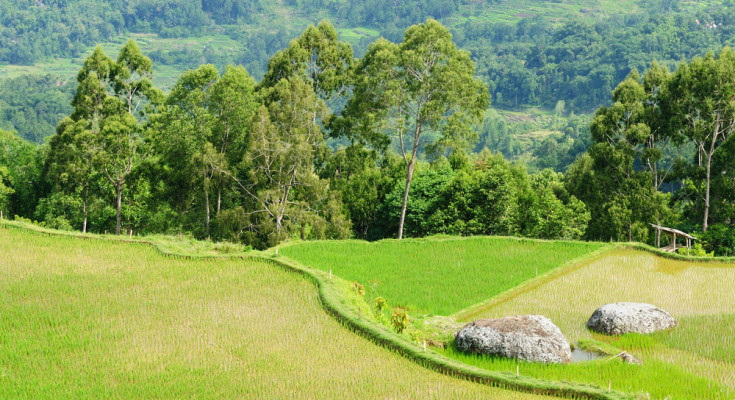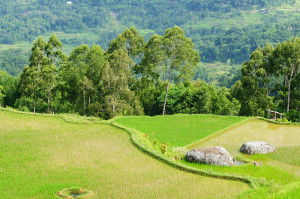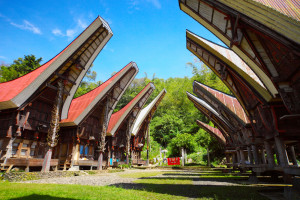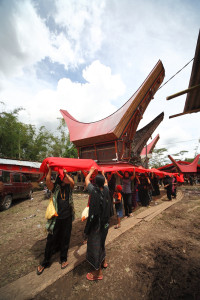By: Megan James
|
There are many parts of the world where blue-eyed blondes are considered the most beauteous of their species, but nowhere in the world are they more highly prized than in Tana Toraja, South Sulawesi. July and August—when the rains have stopped and the rice harvest is safely stored in each house’s ornate rice barn—is funeral season. Every second day another funeral party begins: each is a palm wine, pork and buffalo meat extravaganza with thousands of guests. Most days during these months, you’ll see truckloads of black-clad guests traveling the single-lane, winding roads and yet more guests threading their way along the tracks between rice fields to the tiny villages dotted across the Torajan hillsides. Many of them will be leading buffalos as gifts for slaughter at the funeral feast. If you follow them, you will arrive at a whole compound of buildings, most of which are traditional houses topped with upswept roofs reminiscent of the boats which some say brought the original Torajans from Cambodia thousands of years ago. Around these, temporary dormitories, some of them a hundred meters long, have been built for the possibly thousands of guests who will stay at least one night during the week-long party. This vivacious culture is all the more remarkable for the great attention it pays to death. In Tana Toraja, the birth of a child is greeted with joy, as is a marriage or the completion of a new house. But the major tenet of the ancient animism, that still pervades all aspects of life in Toraja, is that your funeral is the party of your life. Day four or five is usually the highlight of the funeral. This is when the buffalos are killed and parcels of meat given out to guests. But in Tana Toraja, buffalos signify much more than mere meat. The number of buffalos given to the grieving family is a sign of how important and well-regarded the deceased was in the community.1 Perhaps even more importantly, the value of the buffalo given reflects the status of the family giving it. For this reason, the size and price of each animal paraded around the central funeral compound with each new procession of guests is recorded carefully in a book. Not only does this allow the grieving family to reciprocate with an equally expensive gift when a member of the donor family dies, it also ensures that everybody knows who gave the most. In Toraja, it’s not big houses and fancy cars that are the main commodity of conspicuous consumption, it’s buffalos. What makes one buffalo more expensive than another? It’s not, as you might expect, a matter of how useful it will be in the fields or for breeding. The value, in terms of both money and respect for the deceased, is indeed according to buffalo beauty, and in Toraja the most prized are the rare blue-eyed albino with brown patches, called saleko. While ordinary buffalos start at a few million rupiah, mature male albinos now cost between sixty and seventy million rupiah, while those with the bluest eyes and longest horns can fetch up to one hundred and twenty million rupiah at the weekly buffalo market in the town of Rantepao—an extraordinary amount in a land where laborers earn ten thousand rupiah a day. Albinos result randomly from the breeding of ordinary brown or black buffalos: a fair-skinned male and female are no more likely to produce fair-skinned offspring than two ordinary plough pullers, and locals swear that these arbitrary outcomes occur only in Albinos Toraja. Until some lucky person works out what particular kink in the double helix results in an albino, such buffalos will remain rare and expensive. According to one local guide, the price of the best albinos has gone up in recent years as Torajans attach ever greater status to the giving of expensive funeral buffalos. These buffalos never work in the field, need eight years of the sweetest fodder before they reach their maximum sale price, and cost their owners quite a lot in shampoo too. “It’s a Torajan joke,” says local guide Kornelius Palinggi. “The buffalo keepers don’t always take a wash, but their buffalos use shampoo every day.” Moreover, the numbers of buffalo being given at each funeral keeps growing. “It used to be that the biggest funeral—for a member of a royal family—was a twenty-four-buffalo funeral,” says Kornelius. “Now some people have sixty buffalos for a funeral, and at one funeral they had two hundred.” After all, since more than ninety percent of Torajans are now at least nominally Christian, the buffalos are no longer officially ‘sacrificed’ to carry the spirit of the dead to heaven, but merely ‘slaughtered’ to feed the multitudes of guests. At over a hundred million rupiah a beast, there are cheaper but just as delicious cuts of meat to be had. But the family of the deceased risks being ostracized should they try to save even one buffalo from slaughter. “My family presented an eighty-million-rupiah albino at the funeral of one of my distant relatives last week,” said Kornelius. “The family members we gave it to did not want to kill it. They wanted to keep it for themselves. But my mother said she would no longer regard them as family if they did not slaughter the beast, as it would mean that they were refusing the condolences of our side of the family. Eventually, the family of the deceased did the right thing and killed the animal, so now family relations are fine again.”2 The funeral in July of a ninety-five-year-old member of the Torajan royal family at the village of Randon Batu was a twenty-four-buffalo affair. All the buffalos were slaughtered to feed the thousands of guests and local people who just dropped in for their portion of meat. Perhaps five hundred guests stayed in the temporary housing to dance the badon and chant into the night, with many cigarettes, much palm wine and pork and buffalo meat completing the huge social event. During the night the genealogy of the deceased was told, and the more universal story of ‘the way of the soul’ for Torajans. It’s a story of how the original Torajans came from Cambodia perhaps four and a half thousand years ago. Some settled in North Sumatra to become the Batak people, others in Borneo to become the Dayaks, while the third group sailed up the Sadan River in First humans South Sulawesi as far as Enrekang, around fifty kilometers from the current center of Tana Toraja, Rantepao. Enrekang loosely translates as ‘the place where people stepped ashore’ and it was where, according to the stories, the first Torajans settled. Legend has it that they used their boats as houses, establishing the tradition of Torajan roofs with the upswept ends. Very near Enrekang is a mountain which the first inhabitants named Puya, or ‘lady mountain’. Over the centuries, Puya came to be seen as they place where humans first ‘came to earth’. When a second wave of migrants came up-river some thousand years later, the earlier arrivals moved further into the mountains, to establish what is now Rantepao. Still, it’s back to Puya that Torajans believe the soul of the deceased travels on the spirit of the sacrificed buffalo. But for upper-class Torajans, Puya is not a final spiritual resting place. The family of the deceased must hold a much smaller second funeral about a year after the first, erecting a menhir, or sacred stone, at one of a select number of fields in Toraja. Only then will the soul of the relative be elevated to the true heaven and become a deity, who can then represent the family’s interests to the gods themselves. At least, that’s true for the seven or so percent of Torajans who still hold firm to animist beliefs; but most Torajans these days are Protestant. In fact, the Torajan Protestant church is one of the biggest in Indonesia and was the first to accept women as ministers. Many funerals now blend the old animism with Protestantism, mostly with complete equanimity. For instance, in the midst of the animist traditions, a Protestant service is delivered each day at noon and again before the evening festivities, led by the local minister. “So we keep the tradition, but we don’t follow the ritual,” says Kornelius. “We have new beliefs, but we respect the old ones too.” But one unintended consequence of funeral season is that Torajans’ cholesterol levels increase drastically because of all the pork and buffalo consumed. When you factor in higher alcohol consumption than is usual for most Indonesians and the ‘national sport’ of smoking for Indonesian men, as the guide Kornelius put it, you have the formula for a big health problem. “Torajans eat so much meat that hypertension and cholesterol are now the biggest killer of Torajan males,” Kornelius said. While these problems are not unique to Torajan males, perhaps Torajans take consolation in knowing they’ll be sent off in style. And how does the meat of a top-price albino buffalo taste any different? “Just the same. You can’t tell any difference.” Images by Shutterstock First published in Latitudes Magazine |














